湘少版四年级英语上册复习课教案1-3单元教案
- 格式:doc
- 大小:15.50 KB
- 文档页数:3
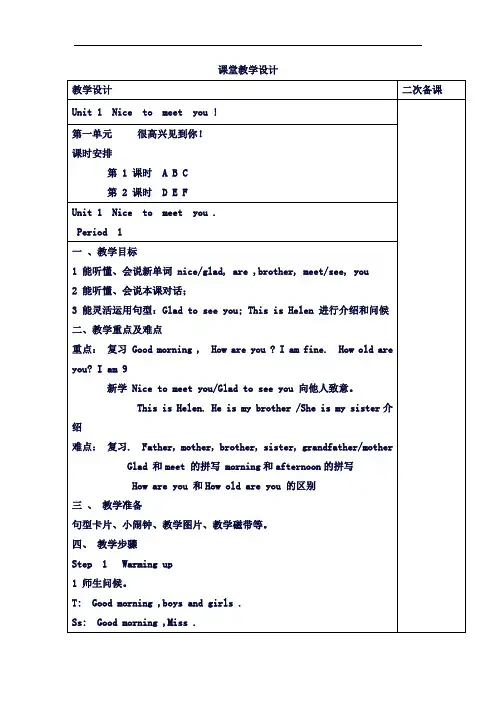
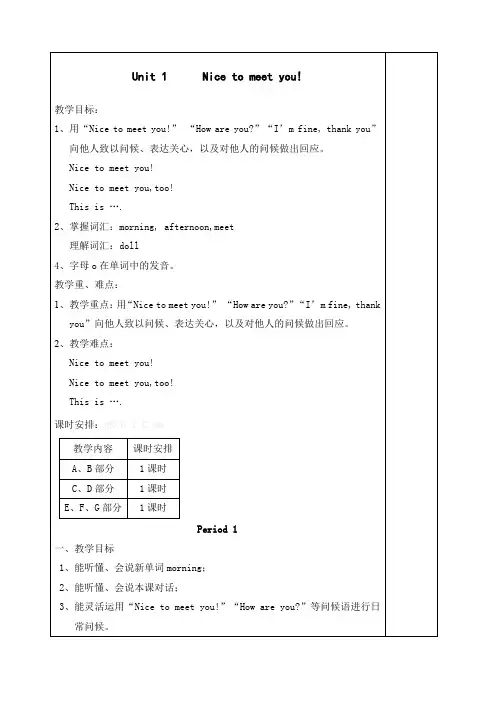

湘少版四年级英语上册教案全册文档编制序号:[KK8UY-LL9IO69-TTO6M3-MTOL89-FTT688]Unit 1 Nice to meet you!教学目标:1、用“Nice to meet you!”“How are you”“I’m fine, thank you”向他人致以问候、表达关心,以及对他人的问候做出回应。
Nice to meet you!Nice to meet you,too!This is ….2、掌握词汇:morning, afternoon,meet理解词汇:doll4、字母o在单词中的发音。
教学重、难点:1、教学重点:用“Nice to meet you!”“How are you”“I’m fine, thankyou”向他人致以问候、表达关心,以及对他人的问候做出回应。
2、教学难点:Nice to meet you!Nice to meet you,too!This is ….课时安排:xK b omPeriod 1一、教学目标1、能听懂、会说新单词morning;2、能听懂、会说本课对话;3、能灵活运用“Nice to meet you!”“How are you”等问候语进行日常问候。
二、教学重点及难点重点:用“Nice to meet you!”“How are you”向他人致意。
难点:This is ….三、教学准备句型卡片、小闹钟、教学挂图、教学磁带等。
四、教学步骤Step 1 Warming up1、师生问候。
T: Good morning, boys and girls.S: Good morning, Miss Zeng.2、游戏——击鼓传球击鼓传球,鼓声停时,球落在谁的手里,则需迅速地用一个单词描叙他的暑假生活,如happy, good等。
Step 2 Presentation and drill1、复习。
老师用不同的问候语向不同的学生进行问候。
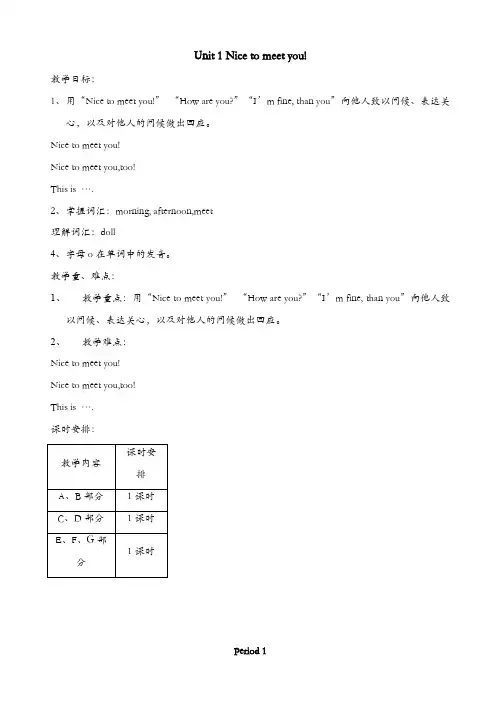
Unit 1 Nice to meet you!教学目标:1、用“Nice to meet you!”“How are you?”“I’m fine, than you”向他人致以问候、表达关心,以及对他人的问候做出回应。
Nice to meet you!Nice to meet you,too!This is ….2、掌握词汇:morning, afternoon,meet理解词汇:doll4、字母o在单词中的发音。
教学重、难点:1、教学重点:用“Nice to meet you!”“How are you?”“I’m fine, than you”向他人致以问候、表达关心,以及对他人的问候做出回应。
2、教学难点:Nice to meet you!Nice to meet you,too!This is ….课时安排:Period 1一、教学目标1、能听懂、会说新单词morning;2、能听懂、会说本课对话;3、能灵活运用“Nice to meet you!”“How are you?”等问候语进行日常问候。
二、教学重点及难点重点:用“Nice to meet you!”“How are you?”向他人致意。
难点:This is ….三、教学准备句型卡片、小闹钟、教学挂图、教学磁带等。
四、教学步骤Step 1 Warming up1、师生问候。
T Good morning, boys and girls.S Good morning, Miss eng.2、游戏——击鼓传球击鼓传球,鼓声停时,球落在谁的手里,则需迅速地用一个单词描叙他的暑假生活,如happy, good等。
Step 2 Presentation and drill1、复习。
老师用不同的问候语向不同的学生进行问候。
T Hello, S1. Nice to meet you.S1 Nice to meet you ,too.T(向另一个学生)Hi, what’s your name?S2 My name is S2.T Glad to meet you. http//ww w.b1S Glad to meet you too.然后,老师把闹钟分别拨到不同的时间(上午九点、下午三点、晚上八点)。
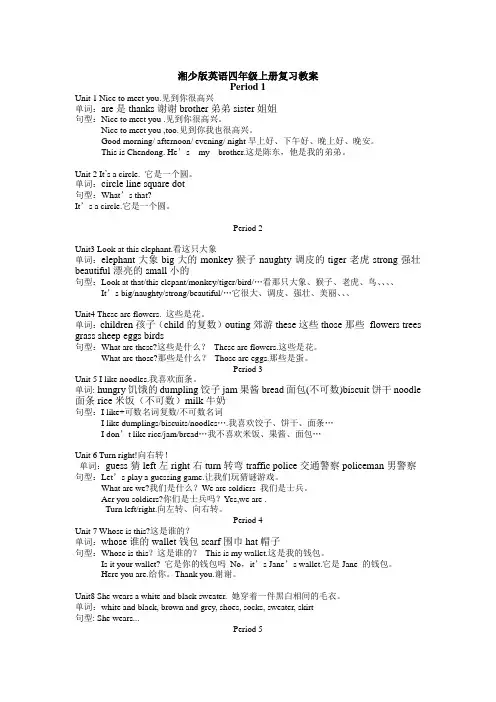
湘少版英语四年级上册复习教案Period 1Unit 1 Nice to meet you.见到你很高兴单词:are是thanks谢谢brother弟弟sister姐姐句型:Nice to meet you .见到你很高兴。
Nice to meet you ,too.见到你我也很高兴。
Good morning/ afternoon/ evening/ night早上好、下午好、晚上好、晚安。
This is Chendong. He’s my brother.这是陈东,他是我的弟弟。
Unit 2 It’s a circle. 它是一个圆。
单词:circle line square dot句型:What’s that?It’s a circle.它是一个圆。
Period 2Unit3 Look at this elephant.看这只大象单词:elephant大象big大的monkey猴子naughty调皮的tiger老虎strong强壮beautiful漂亮的small小的句型:Look at that/this elepant/monkey/tiger/bird/…看那只大象、猴子、老虎、鸟、、、、It’s big/naughty/strong/beautiful/…它很大、调皮、强壮、美丽、、、Unit4 These are flowers. 这些是花。
单词:children孩子(child的复数)outing郊游these这些those那些flowers trees grass sheep eggs birds句型:What are these?这些是什么?These are flowers.这些是花。
What are those?那些是什么?Those are eggs.那些是蛋。
Period 3Unit 5 I like noodles.我喜欢面条。
单词: hungry饥饿的dumpling饺子jam果酱bread面包(不可数)biscuit饼干noodle 面条rice米饭(不可数)milk牛奶句型:I like+可数名词复数/不可数名词I like dumplings/biscuits/noodles….我喜欢饺子、饼干、面条…I don’t like rice/jam/bread…我不喜欢米饭、果酱、面包…Unit 6 Turn right!向右转!单词:guess猜left左right右turn转弯traffic police交通警察policeman男警察句型:Let’s play a guessing game.让我们玩猜谜游戏。
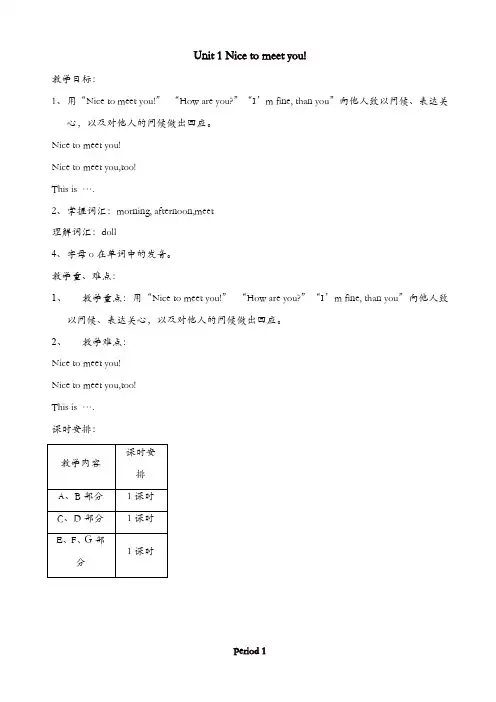
Unit 1 Nice to meet you!教学目标:1、用“Nice to meet you!”“How are you?”“I’m fine, than you”向他人致以问候、表达关心,以及对他人的问候做出回应。
Nice to meet you!Nice to meet you,too!This is ….2、掌握词汇:morning, afternoon,meet理解词汇:doll4、字母o在单词中的发音。
教学重、难点:1、教学重点:用“Nice to meet you!”“How are you?”“I’m fine, than you”向他人致以问候、表达关心,以及对他人的问候做出回应。
2、教学难点:Nice to meet you!Nice to meet you,too!This is ….课时安排:Period 1一、教学目标1、能听懂、会说新单词morning;2、能听懂、会说本课对话;3、能灵活运用“Nice to meet you!”“How are you?”等问候语进行日常问候。
二、教学重点及难点重点:用“Nice to meet you!”“How are you?”向他人致意。
难点:This is ….三、教学准备句型卡片、小闹钟、教学挂图、教学磁带等。
四、教学步骤Step 1 Warming up1、师生问候。
T Good morning, boys and girls.S Good morning, Miss eng.2、游戏——击鼓传球击鼓传球,鼓声停时,球落在谁的手里,则需迅速地用一个单词描叙他的暑假生活,如happy, good等。
Step 2 Presentation and drill1、复习。
老师用不同的问候语向不同的学生进行问候。
T Hello, S1. Nice to meet you.S1 Nice to meet you ,too.T(向另一个学生)Hi, what’s your name?S2 My name is S2.T Glad to meet you. http//ww w.b1S Glad to meet you too.然后,老师把闹钟分别拨到不同的时间(上午九点、下午三点、晚上八点)。
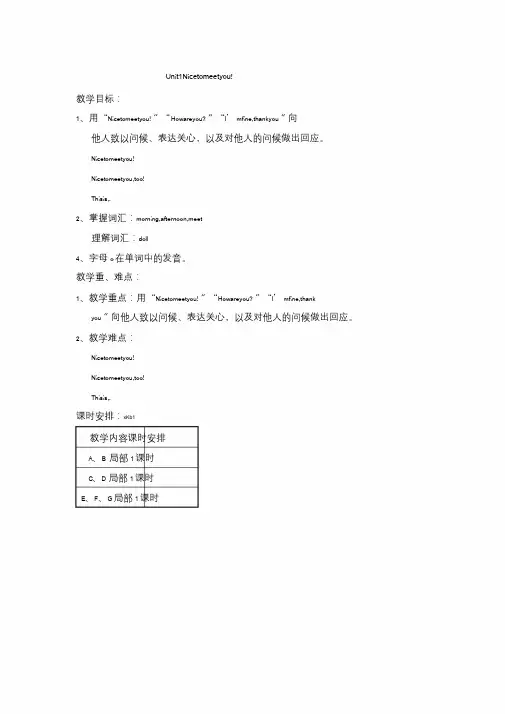
Unit1Nicetomeetyou!教学目标:1、用“Nicetomeetyou!〞“Howareyou?〞“I’mfine,thankyou〞向他人致以问候、表达关心,以及对他人的问候做出回应。
Nicetomeetyou!Nicetomeetyou,too!Thisis,.2、掌握词汇:morning,afternoon,meet理解词汇:doll4、字母o在单词中的发音。
教学重、难点:1、教学重点:用“Nicetomeetyou!〞“Howareyou?〞“I’mfine,thankyou〞向他人致以问候、表达关心,以及对他人的问候做出回应。
2、教学难点:Nicetomeetyou!Nicetomeetyou,too!Thisis,.课时安排:xKb1教学内容课时安排A、B局部1课时C、D局部1课时E、F、G局部1课时Period1一、教学目标1、能听懂、会说新单词morning;2、能听懂、会说本课对话;3、能灵活运用“Nicetomeetyou!〞“Howareyou?〞等问候语进展日常问候。
二、教学重点及难点重点:用“Nicetomeetyou!〞“Howareyou?〞向他人致意。
难点:Thisis,.三、教学准备句型卡片、小闹钟、教学挂图、教学磁带等。
四、教学步骤Step1Warmingup1、师生问候。
T:Goodmorning,boysandgirls.S:Goodmorning,MissZeng.2、游戏——击鼓传球击鼓传球,鼓声停时,球落在谁的手里,那么需迅速地用一个单词描叙他的暑假生活,如happy,good等。
Step2Presentationanddrill1、复习。
教师用不同的问候语向不同的学生进展问候。
T:Hello,S1.Nicetomeetyou.S1:Nicetomeetyou,too.T〔向另一个学生〕:Hi,what’syourname?S2:MynameisS2.T:Gladtomeetyou.://xkb1S:Gladtomeetyoutoo.然后,教师把闹钟分别拨到不同的时间〔上午九点、下午三点、晚上八点〕。
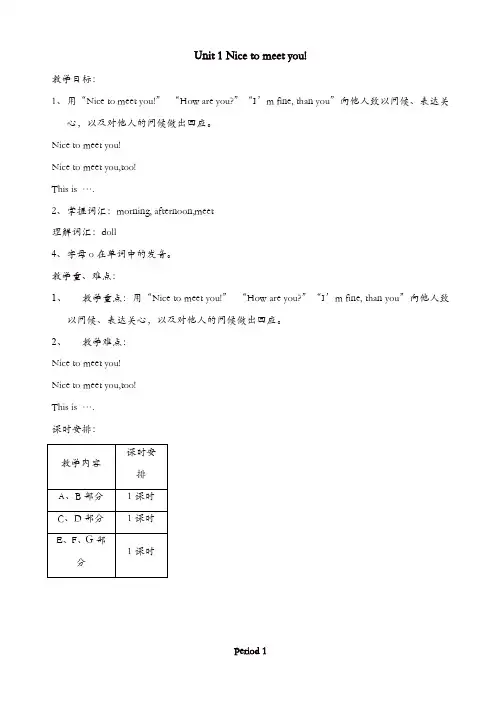
Unit 1 Nice to meet you!教学目标:1、用“Nice to meet you!”“How are you?”“I’m fine, than you”向他人致以问候、表达关心,以及对他人的问候做出回应。
Nice to meet you!Nice to meet you,too!This is ….2、掌握词汇:morning, afternoon,meet理解词汇:doll4、字母o在单词中的发音。
教学重、难点:1、教学重点:用“Nice to meet you!”“How are you?”“I’m fine, than you”向他人致以问候、表达关心,以及对他人的问候做出回应。
2、教学难点:Nice to meet you!Nice to meet you,too!This is ….课时安排:Period 1一、教学目标1、能听懂、会说新单词morning;2、能听懂、会说本课对话;3、能灵活运用“Nice to meet you!”“How are you?”等问候语进行日常问候。
二、教学重点及难点重点:用“Nice to meet you!”“How are you?”向他人致意。
难点:This is ….三、教学准备句型卡片、小闹钟、教学挂图、教学磁带等。
四、教学步骤Step 1 Warming up1、师生问候。
T Good morning, boys and girls.S Good morning, Miss eng.2、游戏——击鼓传球击鼓传球,鼓声停时,球落在谁的手里,则需迅速地用一个单词描叙他的暑假生活,如happy, good等。
Step 2 Presentation and drill1、复习。
老师用不同的问候语向不同的学生进行问候。
T Hello, S1. Nice to meet you.S1 Nice to meet you ,too.T(向另一个学生)Hi, what’s your name?S2 My name is S2.T Glad to meet you. http//ww w.b1S Glad to meet you too.然后,老师把闹钟分别拨到不同的时间(上午九点、下午三点、晚上八点)。

湘少版四年级英语上册教案全册文档编制序号:[KK8UY-LL9IO69-TTO6M3-MTOL89-FTT688]Unit 1 Nice to meet you!教学目标:1、用“Nice to meet you!”“How are you”“I’m fine, thankyou”向他人致以问候、表达关心,以及对他人的问候做出回应。
Nice to meet you!Nice to meet you,too!This is ….2、掌握词汇:morning, afternoon,meet理解词汇:doll4、字母o在单词中的发音。
教学重、难点:1、教学重点:用“Nice to meet you!”“How are you”“I’m fine,thank you”向他人致以问候、表达关心,以及对他人的问候做出回应。
2、教学难点:Nice to meet you!Nice to meet you,too!This is ….课时安排:xK b omPeriod 1一、教学目标1、能听懂、会说新单词morning;2、能听懂、会说本课对话;3、能灵活运用“Nice to meet you!”“How are you”等问候语进行日常问候。
二、教学重点及难点重点:用“Nice to meet you!”“How are you”向他人致意。
难点:This is ….三、教学准备句型卡片、小闹钟、教学挂图、教学磁带等。
四、教学步骤Step 1 Warming up1、师生问候。
T: Good morning, boys and girls.S: Good morning, Miss Zeng.2、游戏——击鼓传球击鼓传球,鼓声停时,球落在谁的手里,则需迅速地用一个单词描叙他的暑假生活,如happy, good等。
Step 2 Presentation and drill1、复习。
老师用不同的问候语向不同的学生进行问候。
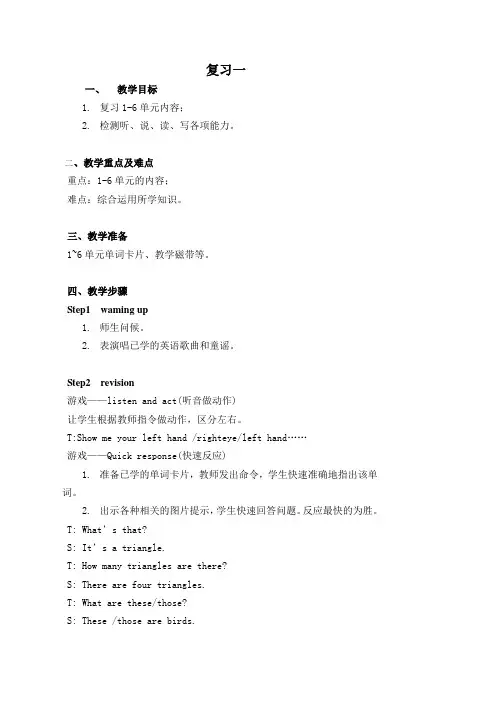
复习一一、教学目标1.复习1-6单元内容;2.检测听、说、读、写各项能力。
二、教学重点及难点重点:1-6单元的内容;难点:综合运用所学知识。
三、教学准备1~6单元单词卡片、教学磁带等。
四、教学步骤Step1 waming up1.师生问候。
2.表演唱已学的英语歌曲和童谣。
Step2 revision游戏——listen and act(听音做动作)让学生根据教师指令做动作,区分左右。
T:Show me your left hand /righteye/left hand……游戏——Quick response(快速反应)1.准备已学的单词卡片,教师发出命令,学生快速准确地指出该单词。
2.出示各种相关的图片提示,学生快速回答问题。
反应最快的为胜。
T: What’s that?S: It’s a triangle.T: How many triangles are there?S: There are four triangles.T: What are these/those?S: These /those are birds.T: What do you like?S: I like eggs.T: What don’t you like?S: I don’t like rice.T: Whose is this ?S: It’s Peter’s pen .游戏——Guess,guess,guess!(猜一猜)一名学生扮演小动物,其他学生猜,并且用一个贴切的形容词形容。
S1: What am I?Ss: A tiger,a strong /big/beautiful/small…….Step 3 Exercise1.学生完成联系,进行自测。
2.检查,讲评。
A部分。
用所给的单词描述一下动物,并将单词写在相应的方格内。
答案: big; naughty ;smallB部分。
听录音,在正确的方格中打勾。
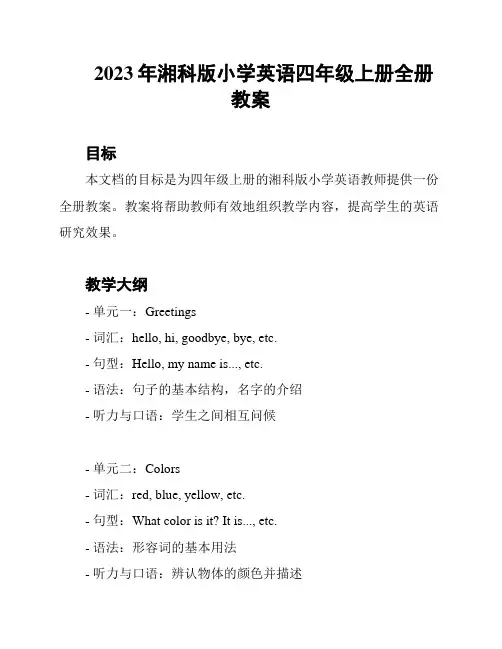
2023年湘科版小学英语四年级上册全册教案目标本文档的目标是为四年级上册的湘科版小学英语教师提供一份全册教案。
教案将帮助教师有效地组织教学内容,提高学生的英语研究效果。
教学大纲- 单元一:Greetings- 词汇:hello, hi, goodbye, bye, etc.- 句型:Hello, my name is..., etc.- 语法:句子的基本结构,名字的介绍- 听力与口语:学生之间相互问候- 单元二:Colors- 词汇:red, blue, yellow, etc.- 句型:What color is it? It is..., etc.- 语法:形容词的基本用法- 听力与口语:辨认物体的颜色并描述- 单元三:Numbers- 词汇:one, two, three, etc.- 句型:How many...? There are..., etc.- 语法:基本数字的表达方式- 听力与口语:数物体并询问数量- 单元四:Fruit- 词汇:apple, banana, orange, etc.- 句型:Do you like...? Yes, I do. / No, I don't., etc. - 语法:情态动词的使用- 听力与口语:询问和回答对水果的喜好- 单元五:Animals- 词汇:dog, cat, bird, etc.- 句型:Can it...? Yes, it can. / No, it can't., etc.- 语法:情态动词的使用- 听力与口语:询问和回答动物的能力教学活动以下是本教案中每个单元的教学活动示例:单元一:Greetings1. 学生之间相互问候,并介绍自己的名字。
2. 教师与学生进行问候,模仿正确的问候方式。
3. 学生小组之间进行问候对话练。
4. 整体练,学生向整个班级问候并介绍自己。
单元二:Colors1. 教师出示不同颜色的物体,并让学生辨认物体的颜色。
四年级新湘少版英语上册教案全册第一章:Unit 1 My Classroom教学目标:1. 能听懂、会说、会读本单元的生词和重点句子。
2. 能用英语简单描述教室的布局和物品。
3. 培养学生的观察能力和表达能力。
教学内容:1. 生词:classroom, desk, chr, blackboard, window, door, teacher, student等。
2. 重点句子:What's this? It's a/an What's that? It's a/an教学步骤:1. 热身活动:让学生描述自己的教室,激发学生的兴趣。
2. 引入新词:展示教室的图片,引导学生说出相应的词汇。
3. 学习句子:通过情景模拟,让学生练习重点句子。
4. 小组活动:学生分组,用英语描述教室的布局和物品。
5. 总结:教师点评学生的表现,强调本节课的重点。
第二章:Unit 2 My Body教学目标:1. 能听懂、会说、会读本单元的生词和重点句子。
2. 能用英语简单描述自己的身体部位。
3. 培养学生的观察能力和表达能力。
教学内容:1. 生词:head, eye, ear, nose, mouth, arm, leg, body等。
2. 重点句子:Where is your? It's here.教学步骤:1. 热身活动:让学生描述自己的身体部位,激发学生的兴趣。
2. 引入新词:展示身体部位的图片,引导学生说出相应的词汇。
3. 学习句子:通过情景模拟,让学生练习重点句子。
4. 小组活动:学生分组,用英语描述自己的身体部位。
5. 总结:教师点评学生的表现,强调本节课的重点。
第三章:Unit 3 My Family教学目标:1. 能听懂、会说、会读本单元的生词和重点句子。
2. 能用英语简单介绍自己的家庭成员。
3. 培养学生的观察能力和表达能力。
教学内容:1. 生词:father, mother, brother, sister, grandma, grandpa等。
最新湘教版四年级上册英语教案(全册)Unit 1: Greetings and IntroductionsLesson 1: Greetings- Objective: To learn basic greetings in English- Teaching Materials: Greeting cards, flashcards, audio recording- Teaching Procedure:- Review previous knowledge on greetings in Chinese- Introduce English greetings through flashcards and audio recording- Practice greetings through role-play activities using greeting cards - Consolidate learning through a class discussion on the importance of greetings in different cultures- Assessment: Observe and provide feedback during role-play activitiesLesson 2: Introductions- Objective: To introduce oneself and others in English- Teaching Materials: Flashcards, name tags, audio recording- Teaching Procedure:- Review English greetings from the previous lesson- Introduce vocabulary for self-introduction using flashcards and audio recording- Model and practice self-introductions in pairs using name tags- Extend the activity to introduce others in the class- Assessment: Observe and assess students' ability to introduce themselves and others accuratelyUnit 2: Numbers and ColorsLesson 1: Numbers 1-10- Objective: To learn numbers 1-10 in English- Teaching Materials: Flashcards, number charts, audio recording - Teaching Procedure:- Review previous knowledge on counting in Chinese- Introduce numbers 1-10 through flashcards, audio recording, and number charts- Practice counting and recognizing numbers through various classroom activities- Assessment: Observe and assess students' ability to count and recognize numbers accuratelyLesson 2: Colors- Objective: To learn basic colors in English- Teaching Materials: Flashcards, color swatches, audio recording - Teaching Procedure:- Review English numbers 1-10 from the previous lesson- Introduce vocabulary for colors using flashcards, audio recording, and color swatches- Practice identifying colors through games and creative activities - Assessment: Observe and assess students' ability to identify colors accuratelyUnit 3: Family and FriendsLesson 1: Family Members- Objective: To learn vocabulary for family members in English- Teaching Materials: Flashcards, family tree visuals, audio recording- Teaching Procedure:- Review previous knowledge on family relationships in Chinese- Introduce vocabulary for family members through flashcards, audio recording, and family tree visuals- Practice using family vocabulary through speaking and writing activities- Assessment: Observe and assess students' ability to use family vocabulary accuratelyLesson 2: Friends- Objective: To talk about friends in English- Teaching Materials: Picture cards, audio recording- Teaching Procedure:- Introduce vocabulary for different types of friends using picture cards and audio recording- Practice describing friends' characteristics and expressing preferences through group discussions- Assessment: Observe and assess students' ability to describe friends accurately and express preferencesUnit 4: Daily RoutinesLesson 1: Daily Activities- Objective: To learn vocabulary for daily activities in English- Teaching Materials: Flashcards, daily routine visuals, audio recording- Teaching Procedure:- Introduce vocabulary for daily activities through flashcards, audio recording, and daily routine visuals- Practice talking about daily activities through role-play and writing activities- Assessment: Observe and assess students' ability to talk about daily activities accuratelyLesson 2: Time and Daily Routine- Objective: To tell time and describe daily routines in English- Teaching Materials: Clock visuals, daily routine visuals, audio recording- Teaching Procedure:- Review English numbers from previous lessons- Introduce vocabulary for time and daily routines through clock visuals, daily routine visuals, and audio recording- Practice telling time and describing daily routines through various activities- Assessment: Observe and assess students' ability to tell time and describe daily routines accurately总结:本教案分为四个单元,每个单元包含两个课时。
四年级新湘少版英语上册教案全册一、第一单元:Hello, Classmates!1. 教学目标1.1 知识目标1.1.2.1 Hello, my name is1.1.2.2 Nice to meet you.1.1.2.3 What's your name?1.1.2.4 How old are you?1.1.2.5 I'm twelve.1.1.2.6 I'm in Class 4, Grade 4.1.1.2.7 What class are you in?1.1.2.8 What subjects do you like?1.1.2.9 I like math.1.1.2.10 I have a pen, a pencil, and an eraser.1.2 能力目标1.2.1 能够用英语进行简单的自我介绍和询问他人信息。
1.2.2 能够用英语介绍自己的学习用品。
1.3 情感目标1.3.1 培养学生的学习兴趣和积极性。
1.3.2 培养学生热爱学校和尊敬老师的情感。
2. 教学重点与难点2.1 重点:单词classmate, teacher, student, school, subject, pen, pencil,eraser, book, bag, puter的认读和运用。
2.2 难点:句子结构的掌握和运用。
3. 教学步骤3.1 Step 1: 热身活动(5分钟)3.1.2 学生模仿教师进行自我介绍。
3.2 Step 2: 引入新课(10分钟)3.2.1 教师展示图片,引导学生说出对应的单词,如:classmate, teacher, student, school, etc.3.2.2 学生跟读单词。
3.3 Step 3: 学习句子(10分钟)3.3.1 教师播放录音,学生听并模仿句子。
3.3.2 学生两人一组进行角色扮演,练习句子。
3.4 Step 4: 实践活动(10分钟)3.4.1 教师组织学生进行小组活动,用所学单词和句子进行交流。
湘少版四年级英语上册复习课教案单元教案 Document number:PBGCG-0857-BTDO-0089-PTT1998复习课l 复习内容:1.衣物的单词 jacket skirt shirt dress…2.颜色的单词 red blur yellow green …3.时刻表达和句型:It’s … It’s time for sth./ to do sth.l 复习目标:1.整合复习1—3单元的词汇、句型,并能正确地听、说、读、写。
2.能综合运用所学的日常交际用语进行交际。
学生能运用句型:It’s .. o’clock. It’s time to / for …l 教学准备:多媒体课件, small books glovesl Teaching Procedure:1. Greeting2. Let’s chant!3. Introduce our friend JohnJohn is a student. He is 9 years old. He is from Canada. He is forgetful. He is always late for school. Look! He lost something in . class again. Let’s guess what he lost.Tips: His favourite colour is grey.4. John goes to the Lost and Found Department to find his clothes. Review words of clothes and colors1) Speak out the corresponding clothes and colors(. blue dress)2) Spell out clothes with different colors, and use them to make sentences in their own words . green skirt ----- The skirt is green.)5. There are so many things in the Lost and Found Department. What on earth is John looking for Maybe you can find it in your text book. Turn to page 41. Let’s find out. Do it in groups of four. John is looking for his grey jacket.6. Let’s take a look at John’s jacket. It’s nice. There is a watch in the pocket. Take out the watch and review the expression of time.1) Sing the song: What time is it now2) Response quickly about the expressions of the time.3) Listen and put up your gloves. That is the teacher’s time table.7. Let’s read.John is very forgetful. Let’s get to know what John does in a day.1) picture walk: see what John does in a day2) Let’s read. Read for the first time and do the exercises in the textbook. Teach students reading skill while the phrases that support your answers.3) Read after the tape and give some suggestions to forgetful John. Teacher writes down the suggestions on the board.. It’s 7:00. It’s time to put on your purple jacket.4) Show John’s small book8. Make your small books1) Make your small books2) Share your small books with your partners in your group3) Raise a question or a statement based on your small books.4) Exchange your small books with your group members. Read the small books and the questions or statements. Give answers to those questions or statements.5) Report9. HomeworkObserve your father’s daily life. Write down your father’s list. Let’s share it tomorrow. “Our Dads’ List”You can also write down your mother’s list, your dog’s list, or your grandma’s list.。
湘少版四年级上、下册英语复习教案第一篇:湘少版四年级上、下册英语复习教案湘少版四年级上册英语复习教案Unit 1-6[ Teaching aims: ]a.语言知识目标:复习目标语句:Nice to meet you!Nice to meet you, too!What’s that? It’s a...Look at this elephant.It’s big.These are flowers.Yes.They are beautiful.I like noodles.I don’t like rice.Turn right!b.语言技能目标:通过复习与操练,能够通过这些语句打招呼,运用句型介绍动物和自己的食物;c.情感态度目标:培养学生学习英语的兴趣,积极参与各项活动。
[ Key points: ]Nice to meet you!What’s that? It’s a...Look at this elephant.It’s big.I like noodles.I don’t like rice.并能在实际情景中运用。
[ Difficult points: ] I like noodles.I don’t like rice.句型的操作和训练。
[Teaching Methods:]The Audio-lingual Method,TPR The Direct Method[ Teaching procedure: ] Ⅰ.Warm-up(热身活动)Sing a song.Ⅱ.Words ReviewA.Read the words of Unit1-Unit6, read after the teacher.B.Make dialogues of this words.Ⅲ.Sentences ReviewA.Read the sentences and how to use the sentences.B.两人小组读课文。
复习课
l 复习内容:
1.衣物的单词 jacket skirt shirt dress…
2.颜色的单词 red blur yellow green …
3.时刻表达和句型:It’s … It’s time for sth./ to do sth.
l 复习目标:
1.整合复习1—3单元的词汇、句型,并能正确地听、说、读、写。
2.能综合运用所学的日常交际用语进行交际。
学生能运用句型:It’s .. o’clock. It’s time to / for …
l 教学准备:
多媒体课件, small books gloves
l Teaching Procedure:
1. Greeting
2. Let’s chant!
3. Introduce our friend John
John is a student. He is 9 years old. He is from Canada. He is forgetful. He is always late for school. Look! He lost something in P.E. class again. Let’s guess what he lost.
Tips: His favourite colour is grey.
4. John goes to the Lost and Found Department to find his clothes. Review words of clothes and colors
1) Speak out the corresponding clothes and colors(e.g. blue dress)2) Spell out clothes with different colors, and use them to make sentences in their own words (e.g. green skirt ----- The skirt is green.)
5. There are so many things in the Lost and Found Department. What on earth is John looking for? Maybe you can find it in your text book. Turn to page 41. Let’s find out. Do it in groups of four. John is looking for his grey jacket.
6. Let’s take a look at John’s jacket. It’s nice. There is a watch in the pocket. Take out the watch and review the expression of time.
1) Sing the song: What time is it now?
2) Response quickly about the expressions of the time.
3) Listen and put up your gloves. That is the teacher’s time table.
7. Let’s read.
John is very forgetful. Let’s get to know what John does in a day.
1) picture walk: see what John does in a day
2) Let’s read. Read for the first time and do the exercises in the textbook. Teach students reading skill while reading.Underline the phrases that support your answers.
3) Read after the tape and give some suggestions to forgetful John. Teacher writes down the suggestions on the board.
E.g. It’s 7:00. It’s time to put on your purple jacket.
4) Show John’s small book
8. Make your small books
1) Make your small books
2) Share your small books with your partners in your group
3) Raise a question or a statement based on your small books.
4) Exchange your small books with your group members. Read the small books and the questions or statements. Give answers to those questions or statements.
5) Report
9. Homework
Observe your father’s daily life. Write down your father’s list. Let’s share it tomorrow. “Our Dads’ List”
You can also write down your mother’s list, your dog’s list, or your grandma’s list.。